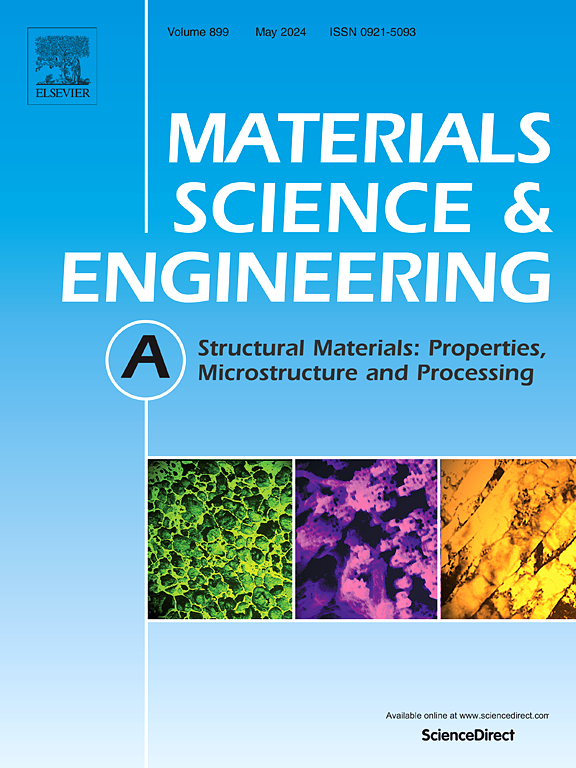具有超高硬度和热稳定性的晶界松弛纳米晶金属钨合金
IF 6.1
2区 材料科学
Q1 MATERIALS SCIENCE, MULTIDISCIPLINARY
引用次数: 0
摘要
金属通常是软的,而陶瓷通常是硬的。金属和陶瓷界一直期待金属能像陶瓷一样坚硬。本研究采用机械合金化和高温高压烧结法制备了钨-1 wt%钇-0.7 wt%钛块体纳米晶(WYT)。高压通过抑制原子扩散直接抑制晶粒生长,通过降低烧结温度间接抑制晶粒生长,从而合成平均晶粒尺寸为~ 9.0 nm的致密NC WYT块体。高温导致烧结块体NC WYT的晶界发生退火和偏析引起的结构松弛,导致GBs的多余体积很小,仅为~ 0.005 nm,是块体NC钨的五分之一。块体NC WYT中细小的晶粒尺寸和松弛的GBs使GBs难以发生位错,从而使其硬度达到23.2±0.3 GPa,屈服强度达到9.4±0.3 GPa,极限抗压强度达到13.1±1.1 GPa。金属块状数控WYT的硬度与陶瓷碳化钨(WC)相当,而块状数控WYT的磨损率甚至低于WC。结构松弛的GBs降低了晶粒生长的热力学驱动力,导致了极高的热稳定性——在高于钨的再结晶温度1500℃的高温下退火的块状NC WYT没有晶粒生长。目前采用高温/高压对数控合金粉末进行多功能处理的方法为制造具有优异机械性能和热稳定性的致密块状数控材料提供了巨大的潜力。本文章由计算机程序翻译,如有差异,请以英文原文为准。
Grain-boundary-relaxed nanocrystalline metallic tungsten alloy with ultra-high hardness and thermal stability
Metals are often soft while ceramics are often hard. To make metals as hard as ceramics has been long-awaited in metals and ceramics communities. In this study, bulk nanocrystalline (NC) tungsten-1 wt% yttrium-0.7 wt% titanium (WYT) was fabricated via mechanical alloying followed by high-temperature/high-pressure sintering. The high pressure directly inhibits grain growth by suppressing atomic diffusion and indirectly inhibits grain growth by lowering sintering temperature, enabling the synthesis of dense NC WYT bulks with an average grain size of ∼ 9.0 nm. The high temperature causes annealing- and segregation-induced structural relaxation of grain boundaries (GBs) in sintered bulk NC WYT, resulting in GBs with a small excess volume of only ∼ 0.005 nm, one fifth that of bulk NC tungsten. The small grain size and the relaxed GBs in the bulk NC WYT make it hard for GBs to emit dislocations, resulting in extremely high hardness of 23.2 ± 0.3 GPa, yield strength of 9.4 ± 0.3 GPa, and ultimate compressive strength of 13.1 ± 1.1 GPa. The hardness of metallic bulk NC WYT is comparable to that of ceramic tungsten carbide (WC) whereas the wear rate of bulk NC WYT is even lower than that of WC. The structure-relaxed GBs lower the thermodynamic driving force for grain growth and result in an extremely high thermal stability - no grain growth occurs in bulk NC WYT annealed at a high temperature of 1500 °C, which is above the recrystallization temperature of tungsten. The present strategy - multifunctional treatments of NC alloy powders by high-temperature/high-pressure - provides a huge potential to manufacture dense bulk NC materials with exceptional mechanical property and thermal stability for practical applications.
求助全文
通过发布文献求助,成功后即可免费获取论文全文。
去求助
来源期刊

Materials Science and Engineering: A
工程技术-材料科学:综合
CiteScore
11.50
自引率
15.60%
发文量
1811
审稿时长
31 days
期刊介绍:
Materials Science and Engineering A provides an international medium for the publication of theoretical and experimental studies related to the load-bearing capacity of materials as influenced by their basic properties, processing history, microstructure and operating environment. Appropriate submissions to Materials Science and Engineering A should include scientific and/or engineering factors which affect the microstructure - strength relationships of materials and report the changes to mechanical behavior.
 求助内容:
求助内容: 应助结果提醒方式:
应助结果提醒方式:


